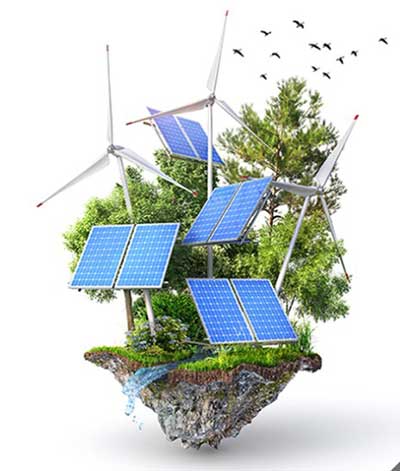Relevance: GS-3: Conservation, Environmental Pollution and Degradation, Environmental Impact Assessment.
Key Phrases: Indian Energy Outlook Report; Energy Access; Lack of coordinated urban planning; Mumbai Climate Action Plan; effects of climate change will cost India $35 trillion until 2070; multi-sectoral convergence and collaborative efforts.
Context
- As per Indian Energy Outlook Report 2021 (by International Energy Agency), India will become 3rd largest energy consumer by 2030.
- By 2050, electricity will have a majority share in the global energy
system.
- Renewables will become the backbone of the electricity generation system.
- This will require countries to make a transition in how power is generated.
- Bloomberg NEF, an energy research firm, estimates that India could fall short of its 2022 renewable energy generation capacity targets by 36%.
Key Highlights
Challenges for India in meeting its Climate Change targets
- Hydrocarbons have played a major role in ensuring energy access.
- Over the past decade, India has added new electricity connections for 50 million people each year.
- Coal and oil have fuelled industrial growth and energy needs.
- The demand for energy is prioritised over climate change targets.
- A 2020 study by Pew Research Centre found that 25% of the Indian population prioritises job creation, even at the cost of the environment.
- Lack of coordinated urban planning
- As per a NITI Aayog report, there is a lack of a master plan in 65% of the country’s 7,933 urban settlements.
- Lack of established methods and procedures to account for losses due
to traditional energy production activities
- Some estimates suggest that the effects of climate change will cost India $35 trillion until 2070 without any intervention.
- This cost doesn’t include the loss of lives lost from increased drought and floods.
- Loss in utilisable renewable energy due to climate change and
pollution
- As per IIT Delhi Report, India with 300 days of sunshine lost 29% of its utilisable solar irradiance due to air pollution.
Achievements of India regarding Climate Change
- Mumbai recently unveiled Climate Action Plan (MCAP) to achieve
carbon neutrality in 2050.
- It is an integrative master plan and is grounded in multi-sectoral convergence and collaborative efforts.
- It has secured a commitment from private power generators to supply 3400 MW of power from renewable energy sources.
- IIT Mumbai has tied up with Indian Meteorological Department to develop sensors to better measure GHG emissions.
- India set itself an ambitious goal of 500 GW of non-fossil fuel
electricity capacity.
- The current renewable energy capacity is 160 GW.
- This target was announced at COP 26 and is to be achieved by 2030.
- In 2021, India added 10 GW of solar capacity or 62% of all new power generation capacity added in 2021.
- Recent Union and State budgets have initiatives regarding climate
change.
- But, these need to be integrated into a concerted approach to ensure that these deliver as per the plan.
- Delhi government has announced that 1 lakh “green” jobs to be created
in five years.
- This must be woven into a multi-state effort to counter the loss of jobs from the closing of thermal power stations.
- This is as per recommendations of the eight-year national “just transition” strategy.
What should India do to catch up and meet its 2030 goals?
- Diversify and strengthen renewable energy sources.
- Rooftop solar power projects must be given a boost.
- Households should be incentivised for such projects.
- Run of river projects, Offshore wind power plants can be explored.
- Urban planning must include GHG emission targets.
- Investment in housing to reduce direct and indirect GHG emissions.
- Electrifying public transport and increasing its accessibility, affordability, and availability.
- More walkable roads and space for cycling must be built.
- Flood resistant drainage systems should be put in place.
- Securing commitments from private power generators to deliver electricity from renewable-only power sources.
- Increasing funds for Green-tech
- Front-loading investments to cater to the demand for green infra.
- India will need higher investment in grid infrastructure, grid automation, distributed grids, and battery storage systems.
- All relevant technologies related to the above sectors exist today but it needs sharper focus for putting them to good use.
- Accurate monitoring system to measure climate change mitigation and
losses due to climate change.
- Due to the rising pollution level, Gigawatt hours is a more representative way to measure solar power generation capacity instead of the number of days of sunshine.
- Lives lost due to climate change-related disasters must be factored in.
- Reducing emissions
- There is a need to boost the efficiency of appliances and systems.
- This can be achieved through initiatives like the National mission on enhanced energy efficiency (NMEEE).
Conclusion
- At the Berlin Energy Transition Dialogues in 2017, Angus McCrone, Chief Editor of Bloomberg NEF, said: “India is an important example of what happens to emissions worldwide.” We must lead by example.
Source: The Hindu BL
Mains Question
Q. What are the challenges to meeting India’s climate change targets? What have been India’s achievements in climate change mitigation? Suggest a suitable way forward.







